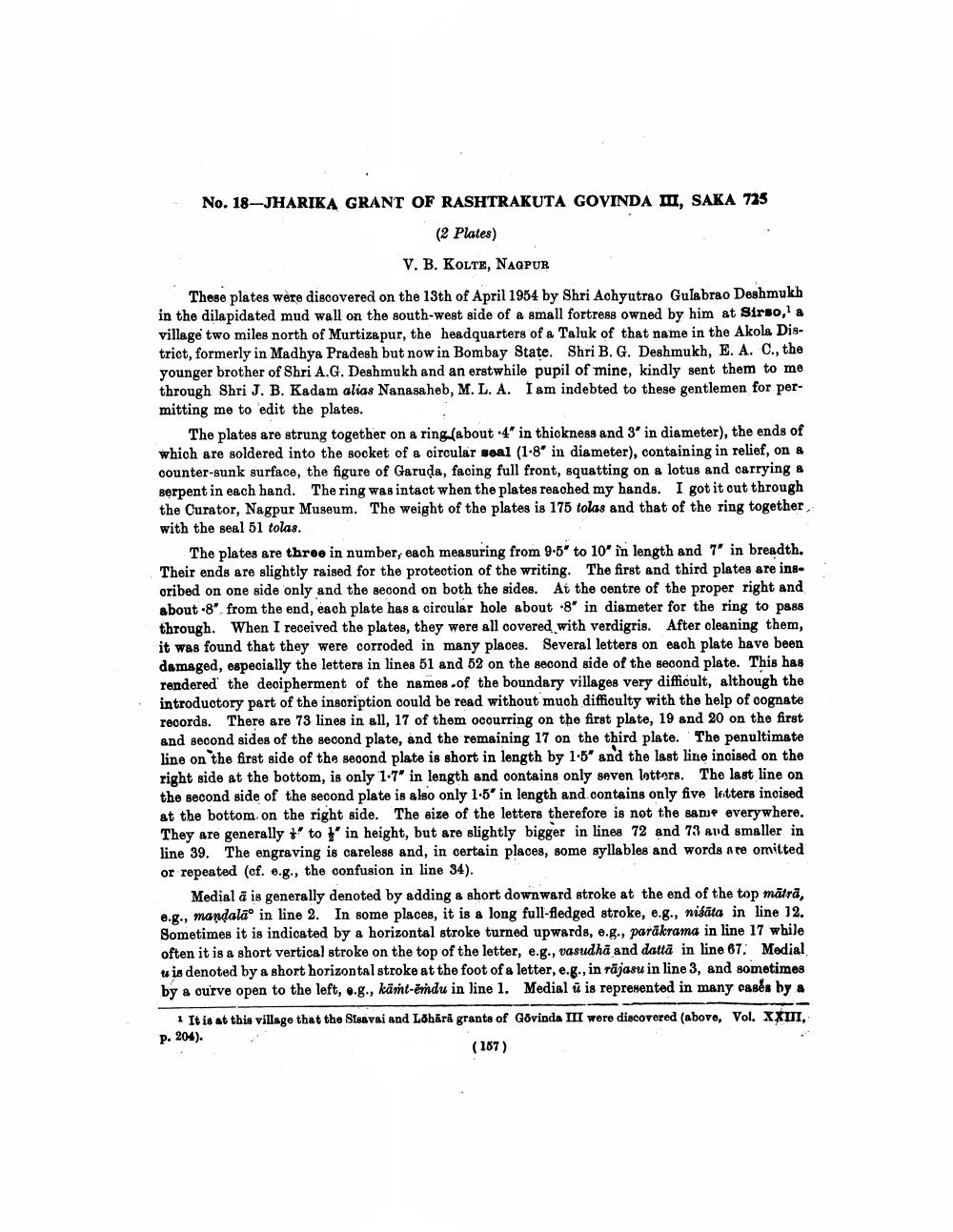________________
No. 18-JHARIKA GRANT OF RASHTRAKUTA GOVINDA III, SAKA 725
(2 Plates)
V. B. KOLTE, NAGPUR
These plates were discovered on the 13th of April 1954 by Shri Achyutrao Gulabrao Deshmukh in the dilapidated mud wall on the south-west side of a small fortress owned by him at Sirso,1 a village two miles north of Murtizapur, the headquarters of a Taluk of that name in the Akola District, formerly in Madhya Pradesh but now in Bombay State. Shri B. G. Deshmukh, E. A. C., the younger brother of Shri A.G. Deshmukh and an erstwhile pupil of mine, kindly sent them to me through Shri J. B. Kadam alias Nanasaheb, M. L. A. I am indebted to these gentlemen for permitting me to edit the plates.
The plates are strung together on a ring (about 4" in thickness and 3" in diameter), the ends of which are soldered into the socket of a circular seal (1-8" in diameter), containing in relief, on a counter-sunk surface, the figure of Garuda, facing full front, squatting on a lotus and carrying a serpent in each hand. The ring was intact when the plates reached my hands. I got it cut through the Curator, Nagpur Museum. The weight of the plates is 175 tolas and that of the ring together, with the seal 51 tolas.
The plates are three in number, each measuring from 9.5" to 10" in length and 7" in breadth. Their ends are slightly raised for the protection of the writing. The first and third plates are inscribed on one side only and the second on both the sides. At the centre of the proper right and about 8" from the end, each plate has a circular hole about 8" in diameter for the ring to pass through. When I received the plates, they were all covered with verdigris. After cleaning them, it was found that they were corroded in many places. Several letters on each plate have been damaged, especially the letters in lines 51 and 52 on the second side of the second plate. This has rendered the decipherment of the names.of the boundary villages very difficult, although the introductory part of the inscription could be read without much difficulty with the help of cognate records. There are 73 lines in all, 17 of them occurring on the first plate, 19 and 20 on the first and second sides of the second plate, and the remaining 17 on the third plate. The penultimate line on the first side of the second plate is short in length by 1.5" and the last line incised on the right side at the bottom, is only 1.7" in length and contains only seven letters. The last line on the second side of the second plate is also only 1.5" in length and contains only five letters incised at the bottom on the right side. The size of the letters therefore is not the same everywhere. They are generally" to " in height, but are slightly bigger in lines 72 and 73 and smaller in line 39. The engraving is careless and, in certain places, some syllables and words are omitted or repeated (cf. e.g., the confusion in line 34).
Medial a is generally denoted by adding a short downward stroke at the end of the top mātrā, e.g., mandala in line 2. In some places, it is a long full-fledged stroke, e.g., nisäta in line 12. Sometimes it is indicated by a horizontal stroke turned upwards, e.g., parakrama in line 17 while often it is a short vertical stroke on the top of the letter, e.g., vasudha and datta in line 67. Medial u is denoted by a short horizontal stroke at the foot of a letter, e.g., in rajasu in line 3, and sometimes by a curve open to the left, e.g., kämt-emdu in line 1. Medial u is represented in many cases by a Govinda III were discovered (above, Vol. XXIII,
1 It is at this village that the Sisavai and Löhärä grants of p. 204).
(187)




